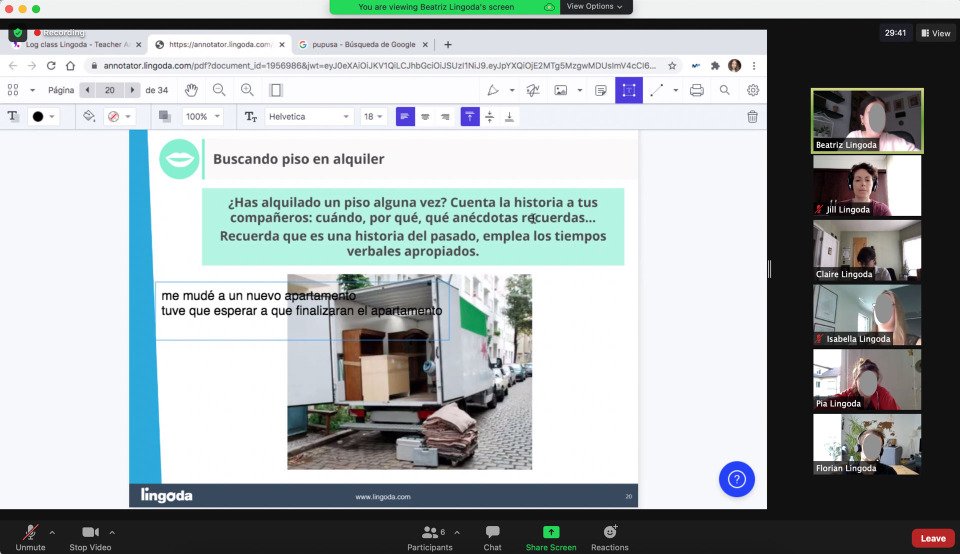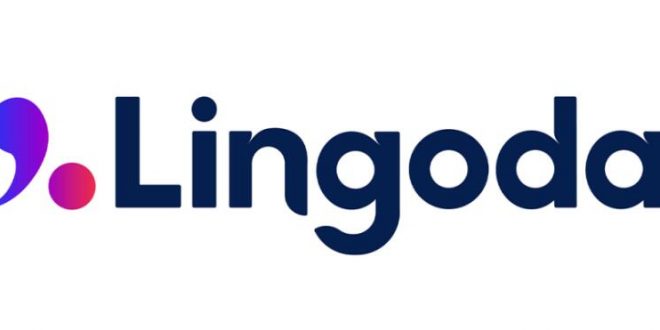What is Lingoda?
Lingoda is an accredited online language academy following the European Framework of Reference for Languages (CECR) to take incoming students from A1 (elementary vocab) to C1 (fluent language).
Upon completion of each level, you receive an official certification which you can use with your school or work visa applications.
Their language and knowledge education approach is rather radical in the online language market. Clearly,they disbelieve in the teaching methods used in online language apps, which constitute over 50% of the language industry’s revenue.
PROS
- Affordable
- Small group and one-on-one language classes via Zoom
- Qualified, enthusiastic instructors
- Good learning materials
- Placement test provided
CONS
- Offers instruction in a few languages
- Does not include a software-based course
LINGODA SPECS
| Price Includes | Small Group Classes and Materials |
| Style of Program | Live Video Call Classes |
| No. of Languages Offered (Not incl. English) | 3 |
What Languages Does Lingoda Offer?
As mentioned, Lingoda offers courses in English, Business English, French, German, and Spanish. The English is taught in British English, although the teachers may come from the US, Canada, South Africa, the UK, and other English-speaking regions.
It’s similar to the other languages. The Spanish course uses Castilian Spanish, although many of the teachers are from Latin America. The German lessons are based on standard German, although there are teachers from Switzerland and Austria. The French class is European French, though you might get an instructor from Canada or La Réunion.
Classes are meant to be immersive and taught in the target language as much as possible. In our testing, however, a beginner German class used English as the language of instruction. In Spanish classes, we tried at the intermediate and higher levels, but very limited to no English was used. A representative from Lingoda confirmed that the English and Business English classes are as immersive as possible and that there wouldn’t necessarily be a language of instruction. Learners can also look at the instructor’s bio before a lesson to see what other languages they speak.

How Much Do Lingoda Classes Cost?
Lingoda offers a variety of plans for both small group classes and one-on-one classes. The prices are quite reasonable, but they vary based on your commitment level and by language. For group classes, limited to five students, the prices are roughly $9.50–$20 per 60-minute class. However, you must pay up front every four weeks for a package of classes, rather than paying per class.
As a quick point of comparison, Rype is an online marketplace that connects language learners to teachers for private lessons, and those classes cost around $7–$10 per 30-minute class.
Here we give an overview of Lingoda’s prices, but see the website for detailed prices and plans.
One-on-One Classes
One-on-one classes start at $132 per month (you pay every four weeks, not by the calendar month) for one 60-minute class per week. So that’s four private classes at a rate of $33 apiece. There are four commitment levels in all, going up to ten classes per week, which costs $760 per month, or $19 per class for 40 classes.
Those rates are for English, French, and Spanish. The price is a little higher for German (about $22–$37 per class) and Business English (about $25–$40 per class).
Small Group Classes
Small group classes of no more than five students cost less. Rates start at $56 per month for four classes (so $14 per class) and go up to $380 per month for 40 classes ($9.50 per class).
Once again, those prices are for English, French, and Spanish. The rates are a little higher for German ($11–$17 per class) and Business English ($13–$19 per class).
Sprints and Super Sprints
Every few months, Lingoda offers two special plans called Sprint and Super Sprint. For these plans, you enroll for three months of classes and commit to taking 15 classes per month in the Sprint or 30 classes per month in the Super Sprint. If you make it to all your classes, you get a 50 percent refund for the Sprint and a 100 percent refund for the Super Sprint. The prices for these plans are:
- Sprint: $216 per month for English, French, or Spanish ($14.40 per class)
- Sprint: $252 per month for German or Business English ($16.80 per class)
- Super Sprint: $372 per month for English, French, or Spanish ($12.40 per class)
- Super Sprint: $445 per month for Business English or German ($14.83 per class)
There are a good number of rules for the Sprint and Super Sprint. These programs fill up fast and may have a waitlist.

The Lingoda Method
Lingoda very specifically does not classify itself as a language learning app. It’s a service that offers classes with teachers.
If you are a beginner, you can enroll in the first level for your chosen language. If you have prior experience with the language, you can take a placement test on the website to find where you should start. The levels are based on the Common European Framework of Reference for Languages (CEFR). The number of levels available varies by language. For example, for Spanish, Lingoda offers A1.1 through B2.3. For German, you can learn all the way up to C1.4. The highest level in this system is C2.
With Lingoda, there is a presumption that you, the learner, will put in some time to learn and study the language on your own beyond the materials you get from Lingoda. When you show up to a class, you should be prepared to practice what you know and learn a little more along the way.
Each class has a topic or theme and a PDF of material that you may download in advance of the class to review. These learning materials have prompts for discussion, short reading passages, and other activities, many of which are designed to be done aloud. By going through the PDF, you can prepare for the class, look up any vocabulary you don’t know, and make notes. In our testing, we found it was worthwhile to set aside about 20 minutes a few hours before a class to review the PDF. Most students should still be able to participate in the class just fine if they don’t put in this learning time in advance.

Lingoda’s Interface
When you create an account with Lingoda, you can log in to see what classes are available on certain days or at certain times. The tools for filtering are great and simple. Before booking a class, Lingoda confirms the time by stating the current time in your time zone. That way, there are no doubts as to what time the class starts.
Every class has a title and description, including the learning emphasis of the class (e.g., speaking, grammar), the name of the instructor with a link to learn more about them, and a number showing how many seats are still available in a group class. When you preview an instructor’s bio, you don’t always find out where they’re from, linguistically speaking. It would be helpful to know in case you prefer instructors from a particular dialectical region, such as Central America versus Spain or Germany versus Switzerland.
If you begin taking classes and find the level is not appropriate, you can change it to be higher or lower at your own discretion.
Inside a Lingoda Class
To test the service, Lingoda provided PCMag with access to German classes for beginners and Spanish classes, following the Sprint plan. The placement test for Spanish, which took less than 15 minutes to complete, seemed accurate in determining the right level.
Classes take place over Zoom. Lingoda provides the link to the class on its website inside your account a few minutes before the start time.
When you join the class, your Zoom name automatically appears as [First Name] Lingoda, for example, Jill Lingoda. No matter what settings you previously had for your display name, your surname won’t ever show.
In most classes, the instructor greets everyone and spends no more than five minutes asking people to share a little information about their biodata, such as where they’re from and their motivation for learning the language. Depending on your language ability, this might be done in English or the language of instruction.
The Learning Material and Instructors
For the bulk of each 60-minute class, the instructor shares their screen to display the PDF for the class. The instructor asks participants to take turns reading a passage aloud, answering a question, or asking a question of another participant. The materials that Lingoda uses are based on CEFR.
The classes are not scripted. Instructors might linger on an activity that is proving useful in getting the learners to speak or skip an exercise if they don’t see the need to complete it. All instructors are required to be at C2 level or above according to CEFR in the language they teach. They must also have a certificate to teach in that language as a foreign language and have at least two years of teaching experience.
Typically, the instructor marks up the PDF as the class works through various exercises, either to make notes or write down corrections and give feedback.
The classes are engaging, and having no more than five students per class keeps them so. When a class has only two or three students, you can really get the most out of it.
Video: On or Off?
Turning on your video camera is optional. Aside from one class where even the instructor kept her camera off, the majority of students and instructors enabled video, which makes for a better class for a number of reasons. For one, you can see when someone’s connection freezes. Another example: The instructor may be able to tell from your facial expression when you need a moment to think about how to respond to a prompt. Additionally, you can see mouth and lip movements, which helps in language learning.
Some classes use the chat feature of Zoom actively. In a few classes, instructors asked the learners to type their replies to a question in the chat. In other classes, the chat doesn’t get used. When the chat is used, Lingoda provides a downloadable copy of it after the class ends.

Class Feedback and Quiz
After each class, you can rate the instructor using a short feedback form.
Additionally, after each completed class, you can optionally take a short quiz on the Lingoda website that’s related to the topic of the class. The quizzes are multiple choice, and they don’t count for anything, but they may help you reinforce what you learned.
What Makes Lingoda Different?
Lingoda excels in small group classes where you hear and speak the language. What it doesn’t offer is a tandem self-paced course of study. That’s not necessarily a bad thing, but it is different from what other online language learning courses offer.
For example, Rosetta Stone offers live online classes to practice speaking and interacting, and each class is directly tied to a course you complete in the Rosetta Stone software, and you can sign up for these classes as you want to use them. For each class, you know what to expect because it’s the same material from the associated lesson. The problem with Rosetta Stone’s classes is they are highly scripted rather than free flowing. In a Lingoda class, the instructor can stop to explain something or perhaps even raise a point about regional linguistic differences. In a Rosetta Stone course, the instructor must stick to the script. In this way, Lingoda’s classes are better.
Similar to Rosetta Stone, Fluenz is a language-learning software program that also offers classes. Unlike Rosetta Stone, however, Fluenz’s classes require a long-term commitment, either 15 hours ($1,500) or 30 hours ($2,800), taught in 90-minute one-on-one sessions with a language coach. You can learn through Fluenz’s program in tandem with using the online software, but it’s strictly required the way it is with Rosetta Stone. Fluenz also sells a six-day travel package language immersion program in Oaxaca, Mexico City, and Barcelona. PCMag has not yet evaluated Fluenz’s classes or travel package, but we have an in-depth review of the Fluenz software.
Who Should Sign Up for Lingoda?
Lingoda’s classes are a wonderful addition to any adult language learning path you may be on and is a PCMag Editors’ Choice winner for language learning—if you want to study one of the languages it offers. It’s accessible to people who are learning a language on their own with apps or those who are familiar with a language through family or cultural exposure and want more instruction. Lingoda gives you the opportunity to speak and communicate with real people, a crucial step to advancing with any language, all within the framework of CEFR standards.
Lingoda FAQs:
Can you get fluent with Lingoda?
Yes, it is possible to develop fluency with Lingoda. However, this is mainly through improving your reading, writing, and speaking skills.
It was originally designed as a supplement for teachers and people taking a traditional course of study. Now, it is good enough to be the main component of your language studies.
It is an excellent way to study at your own pace and still receive feedback about your progress.
Is Lingoda worth the money?
Yes, we would say that Lingoda is worth the money. Whilst it is more expensive than some competitors, we would recommend paying for Lingoda’s classes. They are taught by native tutors as part of a language school, not alanguage app.
Lingoda offers a lot ofgreat resources that are easy to use and small group classes that are easy to join. It is easy to sign up and the language school accommodates learners with different skill levels.
The only problem with the site is the monthly subscription fee. Some users would probably prefer the option to pay a total fee upfront, as is the case with competitors like Rocket Languages.
Is Lingoda legitimate?
Yes, Lingoda is a legitimate online language school offering small group classes, private classes, and online language learning material.
Lingoda recently received a $68 million investmentto help with their international expansion. This was led by Summit Partners, with participation from existing investor Conny Boersch, founder of Mountain Partners.
Lingoda has been running since 2013, withover 1 million users to date.
Lingoda
PROS
-
Affordable
-
Small group and one-on-one language classes via Zoom
-
Qualified, enthusiastic instructors
 Richtheway.com Beauty, Digital, Fashion, Jewerly, Camera, Home.
Richtheway.com Beauty, Digital, Fashion, Jewerly, Camera, Home.




